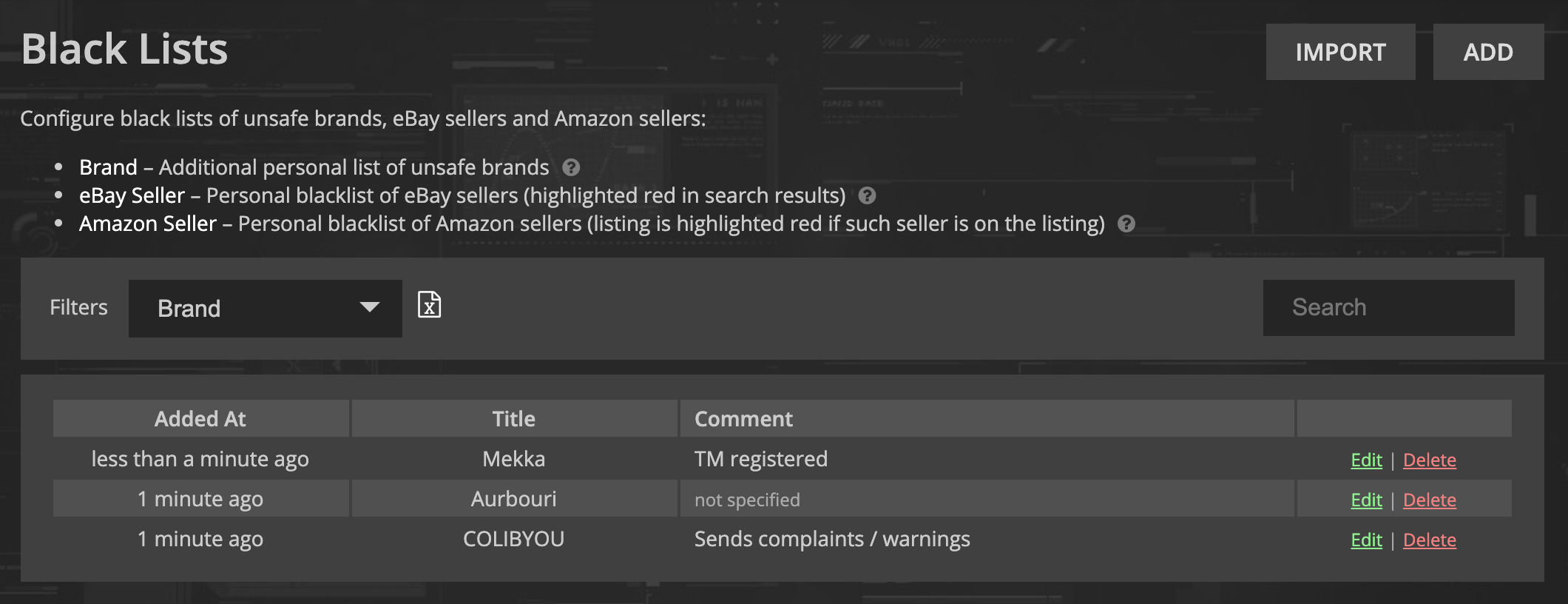One of the main factors for successful work at Amazon with the dropshipping model is high-quality detailed research – primarily for safety. It’s no secret that receiving complaints about infringement of intellectual property rights is one of the main reasons for blocking Amazon seller accounts with the loss of all available funds on the account. Therefore, having a database of dangerous as well as safe brands with the ability to update it is a must-have in the current realities of work.
For these purposes, the platform provides the ability to build and improve these databases using custom Black and White lists. Let’s consider in detail the capabilities of each of them.
Black Lists
We have our own database of dangerous brands, developed over the years, with thousands of names obtained as a result of the analysis of millions items, and based on the [often painful] experience of real sellers. If a brand is on the black list, then when adding a product of this brand to the inventory link it will be highlighted in red, or wherever the name appears in Search and in the Inventory, as well as in the section My Inventory > Brands.

Of course, the world of Amazon is highly dynamic. Every day new brands are added, they reach a new level, develop, change their strategy, and what worked yesterday may no longer be relevant today. Therefore, we added the ability to independently configure blacklists for the following types:
- Brand – an additional personal list of dangerous brands (takes precedence over our global lists of safe and dangerous brands);
- ASIN – list of dangerous Amazon listings (ASINs). For example, if you received any complaints about a listing or had any problems with it, you can add it to this list, and the system will highlight such listing in red so as not to accidentally run into it again;
- eBay Seller – Personal blacklist of eBay sellers (their items are highlighted in red in Search results). For example, it may be unreliable sellers, or who do not work with dropshippers, do not accept payments from abroad, do not accept orders from you specifically, etc.;
- Amazon Seller – Personal blacklist of Amazon sellers (the listing is highlighted in red if such a seller is present on the listing). For example – brand owners, listing hi-jackers, or those who write complaints and A-Z, threaten, extort, dump, etc.
An example of displaying a listing with a blacklisted brand:
White Lists
Our global list of approved brands includes all brands we know that you should not receive a complaint about. But this only applies to the brand. There are also various kinds of complaints, for example, a patent (if the brand is listed as Generic, but the product is patented by the right holder), or the listing may use a brand logo, photo, etc., which can also threaten to receive a copyright complaint, even if the brand whitelisted. Therefore, when searching, you always need to be extremely careful and analyze listings holistically, not only by brand.
In the process of searching for inventory links, sooner or later you will develop your personal vision of approved brands or trusted sellers, so you can safely add them to your personal whitelist for quick identification during the search process:
- Brand – an additional personal list of safe brands – will be highlighted in green wherever its name appears (takes precedence over our global lists of safe and dangerous brands);
- eBay Seller – Personal whitelist of verified eBay sellers (such items are highlighted in green in Search results).
Another example of using personal white lists and black lists (ASIN on the right blacklisted, eBay seller timexpert1 blacklisted, stcarp seller whitelisted):

Import / Export Lists
If you already have your own established black / white lists, you can easily import them into the platform, as well as export them to a table in CSV format.
Important: Your lists are not available to other users – they are only for your personal use on your account.
We are constantly working with filling the database of white and black lists, but still these lists are more of a recommendation in its nature. You should always be very careful to analyze your products for all sorts of violations of Amazon policies in order to ensure the security of your seller account!

